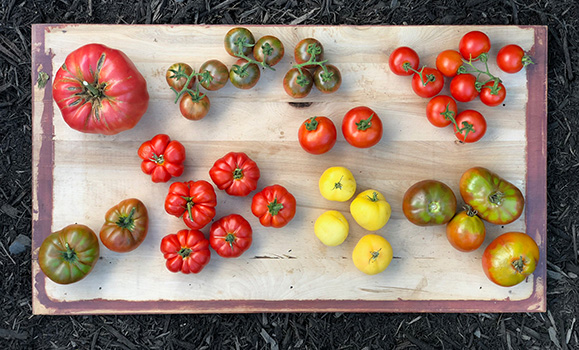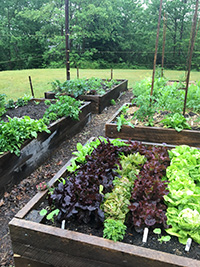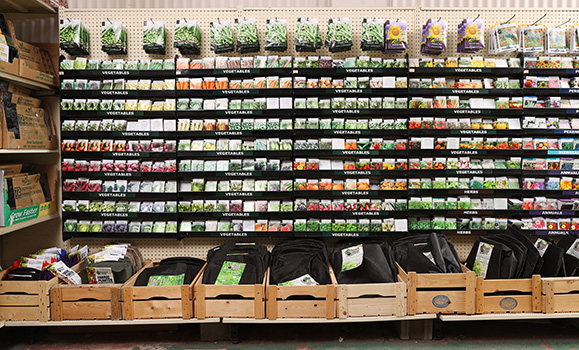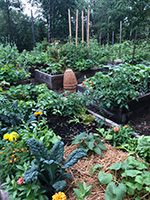FOR MANY OF US, the green, yellow, red and blue stripes of Canada’s Food Guide are etched in memory. I remember learning about it in school and can picture the folksy illustrations of the vegetable, grain, dairy, and meat servings we should have daily. In January 2019, Health Canada unveiled their “new food guide,” which eliminates food groups and recommended servings. Instead, it encourages eating “plenty of vegetables and fruits, whole grain foods, and protein” plus more plant-based choices. While these recommendations are nutritionally sound, they are not realistic for every Canadian. Many healthy food choices are financially out of reach for Canadian families. The COVID-19 pandemic has decreased affordability while increasing our anxiety about food access and supply. Many consumers are exploring alternatives to traditional bricks-and-mortar grocery shopping, including gardening and home food production.
An interdisciplinary research study at Dalhousie (funded by Research Nova Scotia) is exploring these new behaviours. The study, “Home Food Gardening in Response to the COVID-19 Pandemic: Lessons for Food Security Considerations,” uses geographic information systems (GIS) technology and crowdsourcing to collect data on home gardening in Nova Scotia. The research team wants to find out the scope and extent to which Nova Scotians have turned to home food production since the onset of the pandemic, and to examine the impact these activities have on food security in the province.

The flavour of grocery store produce can’t compare to the taste and freshness of home-grown. (Supplied photo)
ACCORDING TO the Food and Agriculture Organization of the United Nations (UN), food security is achieved “when all people, at all times, have physical, social and economic access to sufficient, safe and nutritious food that meets their dietary needs and food preferences for an active and healthy lifestyle.” It’s an issue with multiple dimensions—global and local alike. Seasonal fluctuations, differences in national and international versus household supply, food preparation and utilization, and stability over time all play a role. One can be food secure one minute, and suddenly food insecure the next.
“The foundational factor informing food security is income,” says Kathleen Kevany, associate professor in the Dalhousie Faculty of Agriculture. “Also, food environments—the types of foods available, accessible, and affordable in the area—impact the healthiness of food consumed. Growing some household food addresses a small component of these larger issues.”
Exploring how individuals are coping and creatively wrestling with food insecurity is particularly pertinent in Nova Scotia, which has the highest recorded rate of food insecurity in Canada; nearly one in six households have inadequate access to food. Elizabeth Fitting, associate professor, Sociology and Social Anthropology, teaches a course called Food Activism and is a member of the scientific committee of the Agri-Food Analytics Lab (AAL). “More than four in ten single-mother households suffer food insecurity in this province,” says Dr. Fitting. “Fourteen per cent of those households are living with severe food insecurity.”
As with many systemic social problems, the barriers to food security are highest for low-income people, single parents, women, people with disabilities, seniors, people of African descent, urban Indigenous people, immigrants, and those with intersecting identities. The COVID-19 pandemic has widened existing social gaps. Many have experienced job or housing loss, contributors to further food insecurity. And all of this is heightened by climate change. Jennifer Grek Martin, a lecturer at the School of Information Management and GIS consultant on the AAL study, explains: “We’ve seen massive drought in western Canada this past year, where most Canadian wheat comes from, so what happens to wheat and wheat products like flour? Growers in BC produce an immense amount for the rest of Canada, but the heat, fires, and flooding there recently put this in jeopardy. We need to think about what these things mean for food availability for Canadians and not just assume it will all work out.”
 AGAINST THIS BACKDROP, it’s no surprise that more and more people are looking for ways to take matters into their own hands—with gardening gloves in tow. Yet household food production is an under-researched topic. Health Canada recently published updated recommendations for healthy eating, and little is known about the consumption patterns of these foods here in Nova Scotia. The crowdsourced GIS web application developed by the research team will help fill these gaps. Nova Scotians are invited to submit their home gardening data (such as the garden plot’s location, type of food, and size) into a map. This map presents a great option for visualizing trends related to home food production.
AGAINST THIS BACKDROP, it’s no surprise that more and more people are looking for ways to take matters into their own hands—with gardening gloves in tow. Yet household food production is an under-researched topic. Health Canada recently published updated recommendations for healthy eating, and little is known about the consumption patterns of these foods here in Nova Scotia. The crowdsourced GIS web application developed by the research team will help fill these gaps. Nova Scotians are invited to submit their home gardening data (such as the garden plot’s location, type of food, and size) into a map. This map presents a great option for visualizing trends related to home food production.
“GIS-basedmaps and visualizations are great for storytelling,” says Pallavi Gone, a PhD student and research assistant on the project. “The map enables the public and our team to see and understand patterns and relationships more easily.”
The mapping layers will illustrate home food production “hot spots” in our province. Currently the research is in the data collection phase of a diary study, in which 100 participants are logging their garden spending and output in diaries over a period of 22 months. AAL Research Program Coordinator and lead researcher on the home food gardening study Janet Music explains that the visual representation will highlight problem areas and provide insight into potential solutions. She also hopes it will inform future advocacy. “The data will be given to the provincial government so they can better understand how to support food production here. A lot of what we eat here is imported. The more we can produce here, the shorter the supply chain, and ideally the more sustainable our food chain will be.”
PERSONAL AND COMMUNITY food gardening has a long history. Victory gardening during the First and Second World Wars was seen as patriotic, as it supported food supplies for the front lines. If we consider COVID-19 to be a global enemy, growing food for victory over it can be a patriotic act. However, the AAL study posits that this has little support from government. Halifax Regional Municipality supports community gardens on municipal lands but has a list of strict requirements, including a clear purpose for growing the produce. Community gardens are required to be managed by a non-profit group and membership and participation is application based. This places both a financial and an administrative burden on community groups, most of which are volunteer run.

Despite long Nova Scotia winters, Niki Jabbour says it's still possible to garden year-round. (Supplied photo)
FOOD SECURITY is not the only reason that people are growing their own food. “Gardening is very good for mental health,” says Niki Jabbour. Jabbour is a graduate of the Faculty of Agriculture, and is a professional garden writer, author, radio host, and speaker who specializes in food gardening. Her website SavvyGardening.com is a comprehensive hub of home gardening tips, and she has written four award-winning gardening books. “Gardening forces you to get outside and provides physical exercise. Many people took to it since the pandemic started for these benefits, and as a home-based hobby to combat boredom. Our web visits increased to 2.5 million per month in 2020—it was a boom year—but I noticed an increase in interest in food gardening after the 2008 economic crisis, and that growth hasn’t stopped. Growing your own is a great way to save money and access unusual foods.”
Jabbour stresses that home food gardening can be very simple. Even without a yard, plants can be grown in containers or indoors. Although winters in Nova Scotia are long, gardening can still be a year-round activity. “We are seeing many more home greenhouses, poly tunnels (a type of tunnel greenhouse), and cold frames. Crops like lettuce, arugula, kale, and fresh herbs like parsley and thyme can be grown here in all seasons without supplemental heating.” Her advice for new home gardeners is to start small with one planter or container, plant easy-to grow vegetables such as tomatoes, cucumbers, and bush beans, and do a bit of research to ensure you’re providing proper light and moisture.

Halifax Seed Company is seeing a much younger demographic getting into home gardening. (Nick Pearce photo)
Emily Tregunno, co-owner of The Halifax Seed Company Inc., the oldest continuously operating family-owned seed company in North America, agrees. “The great thing about home gardening is you can make it what you want; you can have one container, or you can supplement all of your vegetables. It is so rewarding to see customers who picked up the hobby in 2020 still coming in. Nurturing plants and working in the soil is a huge stress reliever.” For Tregunno, the flavour of grocery store produce just can’t compare to the taste and freshness of home-grown. The company is seeing a much younger demographic getting into home gardening, including young children. It is an inspiring hobby for all ages. As Tregunno says, “It is great to see your child eat kale [that they helped grow] for the first time when you thought they would never try it.”
Issues of food supply and food security are complex and will, ultimately, require solutions to match. Food research like the AAL study helps illuminate behaviour patterns and system inequities which can inform decision-making. As Grek Martin says, “It will be interesting to see how individual food production develops as external forces like the pandemic and climate change interact with our ability to obtain food. This study is a crucial step towards understanding the relationship between people and food availability at the local level.”
VICTORY REVIVAL |
This story appeared in the DAL Magazine Spring 2022 issue. Flip through the rest of the Spring 2022 issue using the links below.


